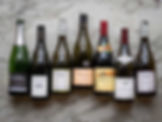AOC Wine - What are French Classifications?
- Caroline
- Jan 10, 2020
- 4 min read
Updated: Jan 13, 2020
What do French wine labels mean? How do classification systems work? What are the main French wine regions?

French Wine Labels
When it comes to French wine, it’s all about location, location, location! French wines are classified and labeled based on the location of the vineyards. This means that whatever village, commune or region they come from, that’s how they get their name.
If you’re someone who loves Pinot Noir or Syrah, you probably won’t see your favorite grapes on French wine labels. Unfortunately, French wine labels almost never list their grape variety. As for tiers of quality, to make things fun for everyone, each region has its own classification system!

What Is AOC (Appellation d’Origine Contrôlée)?
Appellation is the word for the legally defined geographical area that identifies the origin of a wine. It is also used for other things like cheese and meat.
An essential thing to understand is that these are protected names, and the AOC system works to guarantee a certain level of quality. It’s the same as AOP (replace “control” with “protected”), which you also see floating around.
Are you interested in organizing your own French wine tour?
If you want to put “Bordeaux” or “Sancerre” on your label, you have to meet some of the AOC’s specific requirements.
For example:
The producer must make the wine from vines within a certain geographical area.
You can’t use any grape, either.
The AOC requires that you only use specific grapes.
There are rules to winemaking, and to be considered “Bordeaux” or “Sancerre,” the AOC requires that producers follow only certain rules of winemaking.
It’s pretty restrictive, but the value of the wine is closely tied with the value of the place name, which is why they are controlled. This means that no one outside of the limits set by the AOC can use these titles.
So, how are these boundaries defined? What decides an AOC? Well that comes down to terroir.

What is Terroir?
Terroir is a French word that has been adopted throughout the global wine industry.
Often it gets simplified to just refer to the soil, but terroir is a small word with a much bigger meaning.
Terroir does mean vineyard geology, but it can also mean:
the slope of the land
the hill that provides shelter from rain
the tree that shades a certain parcel of vines
the foggy mornings
Terroir is a very broad idea composed of the very specific elements that create a complete and unique environment.
Terroir is about the vineyard and its grapes, and is the foundational idea behind organizing wine classifications on geographical origin.
Regions, Communes, and Crus
So now we understand appellations and terroir, how does that translate to an actual label? What is that label telling you?
It’s important to understand that there are appellations within appellations: think of it like a Russian nesting doll.

A whole region has an appellation. For example, Côtes du Rhône, which defines a very large geographical area. Within the Côtes du Rhône lie smaller communes, which are also appellations, such as Gigondas. Normally that’s where it ends, but in some cases even a single vineyard has its own appellation, as happens with some Grand Crus in Burgundy.
What’s a Cru? It depends on where you are. Not all regions use this word, and some regions use them to further delineate quality levels. Mostly they are used in Bordeaux, Burgundy, and Alsace but they mean different things in each.
IGP and VDF (Indication d’Origine Protégée and Vin de France)
What if you make wine outside of those defined areas? What if you don’t follow all the rules to have the appellation label? Outside of AOCs, there are two other broad classifications.
Indication d’Origine Protégée (IGP) are bigger regions than the broadest AOC regions and have looser restrictions.
Vin de France (VDF) can be put on any French wine, and will often have the grape on the label too, which is helpful.

What is a Good French Wine?
Ultimately, this brings us to a sort of classification pyramid.
At the base is VDF, followed by IGP, then there’s regional AOCs, topped with commune AOCs, with defined Cru AOCs at the top depending upon the region. there’s lots of great value to be found in both of these “bottom tier” classifications!
The whole system is based on the idea that if you choose the labels according to this pyramid, you should be able to trust the level of quality you’re getting.
This is kind of the case, if you only engage in the upper levels, but is misleading when it comes to the base of the pyramid.
There are plenty of great VDFs and IGPs made by winemakers with vines outside of the boundaries of appellations. Many of these winemakers want to work with grapes that aren’t allowed, or who want to try different winemaking techniques.
I think there’s lots of great value to be found in both of these “bottom tier” classifications!
Related Posts:



